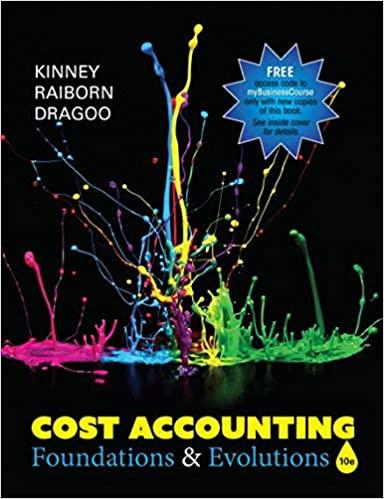Power Production manufactures two product models: Regular and Special. The following information was taken from the accounting
Question:
Power Production manufactures two product models: Regular and Special. The following information was taken from the accounting records for the first quarter of 2013:
.png)
Power currently uses a traditional cost accounting system where total overhead cost is assigned to products based on the total number of units produced. Company president Sue Power has approached the controller, Keisha Connaery, with concerns about sagging profit margins and his inability to explain competitors’ pricing of similar products. Connaery suggests that the company explore the possibility of a costing system that is based less on volume and more on identifying the consumption of resources by products (given manufacturing process activities). Connaery identifies the following overhead costs related to the production process:
Wages and costs related to machine setups .......$360,000
Material handling costs ............... 480,000
Quality control costs ................ 120,000
Other overhead costs related to units produced ...... 240,000
Total ...................... $ 1,200,000
During the quarter, there were 40 machine setups for production: 20 from Special to Regular and 20 from Regular to Special. Connaery believes that the number of setups is the most appropriate cost driver of machine setup costs and material cost is the primary indicator of material handling costs. The Special model uses more expensive and difficult-to-handle materials. Additionally, each Special unit is hand-inspected by quality control personnel because it is more complex and has more parts than a Regular unit. Quality control inspectors are paid $ 40 per hour; examination of payroll time sheets indicates that the inspectors spent 50 percent more hours inspecting Special units than Regular units. Finally, Connaery thinks the remaining 30 percent of overhead costs are related to the number of units produced.
a. Using a traditional, volume-based overhead rate, determine the overhead cost per unit of the Regular and Special units.
b. Using the information provided by Connaery, determine the overhead cost per unit of the Regular and Special Units using an activity-based costing system.
c. What is the total per-unit cost of the Regular and Special Units under each overhead costing system?
d. Compute the amount of product cross-subsidization per unit that was taking place under the traditional costing system.
e. Identify potential non-value-added activities in Power’s current manufacturing system.
f. What suggestions would you have for Sue Power to improve the competitiveness of the company’s products in themarketplace?
Step by Step Answer:

Cost Accounting Foundations And Evolutions
ISBN: 9781618533531
10th Edition
Authors: Amie Dragoo, Michael Kinney, Cecily Raiborn





